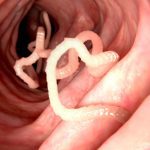 Mysteries
Mysteries  Mysteries
Mysteries  History
History 10 Surprising Stories About the Texas Rangers
 Humans
Humans 10 Philosophers Who Were Driven Mad by Their Own Theories
 Miscellaneous
Miscellaneous 10 Video-Game-Worthy Weapons and Armors from History
 Weird Stuff
Weird Stuff 10 Psychics Who Accurately Predicted Wartime Events
 The Arts
The Arts 10 Pieces of Art Inspired by a Broken Heart
 Health
Health 10 Science Fiction-Sounding New Medical Treatments
 History
History 10 Surprising Facts About the Father of Submarine Warfare
 Space
Space Ten Astonishing New Insights into Alien Worlds
 Weird Stuff
Weird Stuff 10 Bizarre Summer Solstice Rituals Still Practiced Today
 Mysteries
Mysteries Top 10 Haunting Facts About the Ghost Ship MV Alta
 History
History 10 Surprising Stories About the Texas Rangers
 Humans
Humans 10 Philosophers Who Were Driven Mad by Their Own Theories
Who's Behind Listverse?

Jamie Frater
Head Editor
Jamie founded Listverse due to an insatiable desire to share fascinating, obscure, and bizarre facts. He has been a guest speaker on numerous national radio and television stations and is a five time published author.
More About Us Miscellaneous
Miscellaneous 10 Video-Game-Worthy Weapons and Armors from History
 Weird Stuff
Weird Stuff 10 Psychics Who Accurately Predicted Wartime Events
 The Arts
The Arts 10 Pieces of Art Inspired by a Broken Heart
 Health
Health 10 Science Fiction-Sounding New Medical Treatments
 History
History 10 Surprising Facts About the Father of Submarine Warfare
 Space
Space Ten Astonishing New Insights into Alien Worlds
 Weird Stuff
Weird Stuff 10 Bizarre Summer Solstice Rituals Still Practiced Today
Ten Disease-Carrying Bugs and Creepy Crawlies That Cure Diseases
When the average person sees a bug, they think of being bitten, stung, the diseases they carry, and the property they can damage—generally bad thoughts. But what if the bugs we loath could save our lives?
From sniffing out a horrible disease to treating skin conditions, various bugs and insects can come to humanity’s aid. So here are ten disease-carrying creepy crawlies that can also cure diseases. Unfortunately, we may have to deal with the bad to get to the good!
Related: 10 Strange Discoveries And Inventions Involving Insects
10 Flies
Maybe not as bad as roaches or mice, but nobody wants flies buzzing around their food. They can carry disease, lay maggots, and are just irritating. But you may want to pay attention if flies keep buzzing in your ear. See, flies, mosquitos, and other buzzing bugs can smell humans, and it turns out, fruit flies may be able to smell cancer.
In a scientific study done in 2014, German scientists used fruit flies’ strong sense of smell to detect cancer in humans. Flies have also been used in cancer treatment as test subjects. Flies are ideal for quickly and humanely testing out experimental treatments for patients because of their short lifespan and similarity to human nervous systems—and PETA hasn’t complained yet.[1]
9 Beetles
Sometimes mistaken for roaches, beetles are used as a food source for a variety of people across the world. Beetles are the most diverse group of insects, so it makes sense that they have some of the most varied uses in medicine. Different types of beetles have been used in both traditional and modern medicine. Traditionally, beetles have been used in treatments to remove cysts and reduce fever and chills. They’ve been used topically to treat itching and eczema and were believed to improve blood circulation and relieve inflammation and menstrual bleeding.
More recently, researchers have used a blistering agent, cantharidin, found in beetles in medicines. In 1962 cantharidin was up for FDA approval but was denied due to a lack of data. Still, cantharidin, naturally found in certain species of beetles and hard to replicate, has been used by dermatologists to treat warts and other skin afflictions.[2]
8 Worms
Too small to be considered snakes, but just as off-putting to some, even worms can save your life. For starters, worms have been found to be a valuable source of nutrients. Earthworms contain fats, free aminos, high levels of protein, and essential vitamins like iron and calcium. Yum! Traditionally, earthworms have been used everywhere from Laos to America (by Cherokee Indians) to China for every ailment from alopecia and bladder stones to rheumatic pain and jaundice.
Silkworms, though technically not worms (think moth worms and caterpillars), have also been playing a large role in medicine. Scientists in Japan were able to modify silkworms to produce collagen genetically. The collagen, which silkworms already produce in small amounts inside their cocoons, can be used for artificial skin and bones and cosmetic surgeries.[3]
7 Termites
Finding out you have termites is always bad news for your home. But it turns out the little critters are good for more than chewing through wood. One of the most commonly consumed insects, second to only grasshoppers, termites have been used medicinally in several countries. In Brazil, the insect is used to cure asthma, influenza, bronchitis, tonsillitis, and whooping cough, to name a few ailments. They’re used in India to treat ulcers, body pain, and anemia. Zambia uses termites to treat child malnutrition, and the list goes on.
In Western medicine, scientists have been able to extract potent antimicrobial substances from termites. Scientists argue that these extracts could fight against viruses and bacteria that may be immune to other antibiotics. And all over the world, people munch on the maybe-not-so-delicious but highly nutritious termites as they are a potent source of protein.[4]
6 Grasshoppers
Unlike the other bugs mentioned here, grasshoppers and other large hopping bugs of the sort—think crickets, locusts, and katydids—usually aren’t cause for much fanfare. But believe it or not, grasshoppers are a serious superfood! Allegedly with a taste similar to shrimp (will need someone to verify this ’cause eww), grasshoppers are high in protein and fat and have more antioxidants than fresh orange juice.
Grasshoppers can also serve as powerful diuretics, making them ideal for treating ailments like kidney disease and gastrointestinal diseases. Grasshoppers also contain a polysaccharide called chitin which helps fight against dangerous bacteria. And if all that isn’t enough, grasshoppers are easy to digest and can provide more energy than a bowl of Wheaties! Next time you’re looking for a healthy energy-filled breakfast, consider going out to the garden for some grasshoppers.[5]
5 Ants
An entire Listverse article can probably be written about ants as they’re the stuff of legends: smaller, stronger, and much more plentiful than most other insects. When we talk about eating bugs for health benefits, ants are usually one of the first bugs that come to mind. But did you know that the health benefits of ants are so great that they’ve even been used to flavor alcohol to use as a medicine? Ant schnapps, anyone? No? That’s okay. There are so many different types of ants that you can get the medical advantages without eating or drinking them.
For example, red wood ants use formic acid to defend their nest and queen from predators, which can be used topically to heal skin ailments like warts. Leafcutter ants have developed pseudonocardia bacteria to help fight against the harmful fungus surrounding their colony. This evolved bacteria is a powerful antifungal that is used in medicine. Perhaps more practical than any other bug in medicine, ant heads were even used in traditional medicine as an alternative to stitches. Simply have the ant bite a wound closed and then twist off the head, leaving the body in place. Ants are such versatile insects that new medical uses for them are still being discovered today.[6]
4 Leeches
We’ve already discussed worms, so now it’s time for their muscular parasitic cousin, leeches. You’ve seen them in movies—a character walks into a body of water and emerges with a fat blackish-red thing stuck to their face or dangling from their arm. But outside of cliché movie scares, leeches are so useful that leech therapy is still widely used in modern medicine. Leech saliva contains hirudin, an anticoagulant and antiplatelet agent that works to prevent blood clots and reduce the amount of congested blood in the tissues.
Because of their saliva, leech therapy is used in cosmetic and other microsurgeries to help prevent blood clotting and pooling around the tiny veins and cuts doctors must make. This can help prevent all sorts of medical complications, including amputation. Leech saliva has been used in medicine to treat hypertension, varicose veins, hemorrhoids, skin problems, and arthritis. Leech therapy has even been proven useful in patients with heart disease and cancer.[7]
3 Spiders
Loved by some, hated by others. If they’re not catching other pests, spiders usually get a bad reputation for being more harmful than helpful. Which makes sense—they’re poisonous after all, right? Well, sure, but in most places—North America, for example—spider venom has evolved, so it’s most effective on the itty bitty bugs they prey on and not so effective on large mammals. In fact, even more than not being very harmful to humans at all, spider venom can have medical benefits. (Excluded in this statement: Australia. They have way too many killer spiders!)
While arachnid venom (think spiders, scorpions, and ticks) has been used in medicine for everything from cancer to heart disease, researchers have found ways that certain spider venoms stand apart from the rest when it comes to medicinal value. Spider venom targets the nervous system, paralyzing its victim. Researchers have found that medicine made from this venom can be used to target a human’s nervous system the same way, making it useful as pain medication. Other spider venom has been found to contain a protein that stops muscle cells from deteriorating, which could be used to treat a number of diseases that affect muscle mass and the ability to walk, move, or swallow.[8]
2 Maggots
We already talked about their buzzing parents, but maggots get a section all to themselves. At some point, you may have hiked past a rotten animal carcass filled with millions of soon-to-be flies. Rotting flesh is a maggot’s favorite meal! A fly with a life span of 30 days will lay between 500 and 2000 eggs, about 20-70 eggs per day. While some maggots can truly be sinister—lookup bot fly larva for some good nightmares—some have surprising medicinal benefits.
One of the first times maggots were recorded as having a use in medicine was during World War I, when two soldiers with flesh wounds were stranded with no food or water for a week. The soldiers were expected to be found with fatally infected wounds. Instead, doctors found thousands of maggots in the wounds. Upon cleaning the maggots away, doctors found clean, uninfected wounds. After that, maggots were used widely in medicine to treat wounds until the 90s. Today researchers have begun studying the chemicals released from maggots as they remove dead flesh and have found that maggot secretions have useful antibiotic resistance.[9]
1 Bees
Bees are the bees’ knees when it comes to life-saving insects: the queen bee, if you will. Their benefits are far-reaching, from the unending benefits of honey (seriously, honey does everything!) to the benefits of bee venom to bees literally pollinating plants to keep humans alive. Bees are a necessary, often overlooked, part of human life and a useful part of modern medicine. Let’s start with honey. This superfood made from the nectar of flowers and special enzymes from bees’ “honey” stomachs (yeah, bee vomit) can be used as an anti-inflammatory, antioxidant, and antibacterial agent. It is commonly used to treat coughs and sore throats and can treat minor cuts and burns.
Even bees themselves can save lives. For one, the trees and plants that they help pollinate provide not only important food sources for humans but also provide us with oxygen. Even more, bee venom delivered through bee stings can be used to treat a variety of ailments. Apitherapy is an alternative medicine practice that uses bee venom to treat and prevent illnesses, pain, and more. Apitherapy capitalizes on the anti-inflammatory and pain-reducing properties found in bee venom and is used for things like rheumatoid arthritis and chronic pain.[10]








